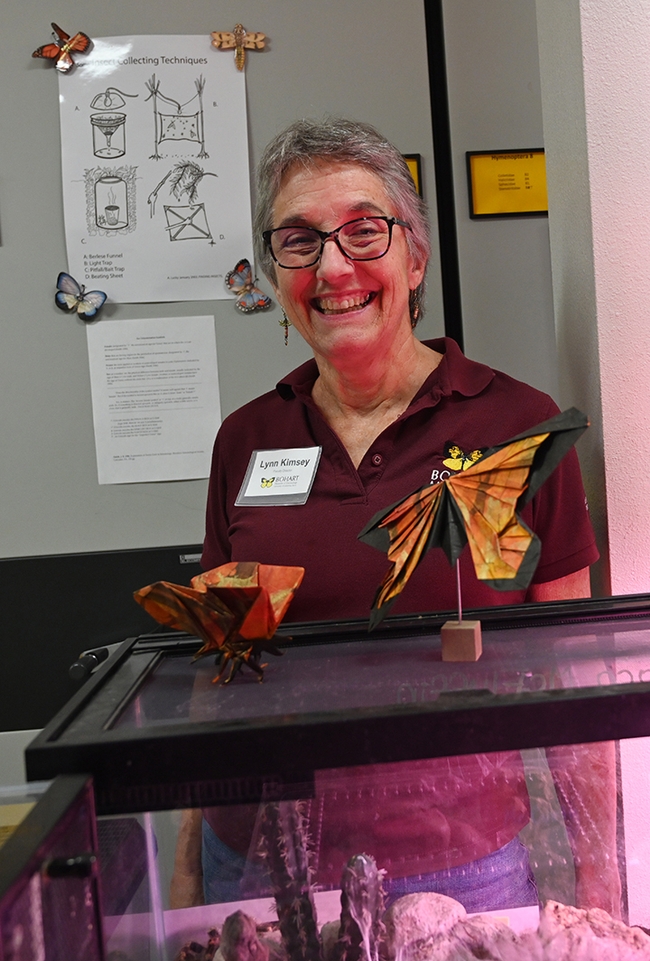
Western monarchs are now settling in their overwintering sites along coastal California, but the iconic butterflies showed up in force at the Bohart Museum of Entomology's recent open house--in the form of specimens, photographs, books, maps and displays.
Some 650 visitors arrived to talk to the scientists, see the displays, and take home native milkweed seed packets, provided by community ecologist Louie Yang, professor of entomology, UC Davis Department of Entomology and Nematology (ENT-NEM). Yang shared seeds of narrow-leafed milkweed, Asclepias fascicularis.
Statistics show that the overwintering population of western monarchs along coastal California has declined by more than 99 percent since the 1980s, according to the Xerces Society for Invertebrate Conservation, but the population has been showing a mini-boom in recent years. Scientists blame habitat destruction, pesticide use, and climate change as the primary causes of the decline.
Scientists participating in the open house were:
- UC Davis distinguished professor emeritus Art Shapiro of the Department of Evolution and Ecology, who has studied butterfly populations in central California since 1972 and maintains a research website, Art's Butterfly World.
- UC Davis emeritus professor Hugh Dingle, a worldwide authority on animal migration, including monarchs. He is the author of Migration: The Biology of Life on the Move (Oxford University Press), a sequel to the first edition published in 1996. (See news story on the ENT-NEM website.)
- UC Davis professor Louie Yang, who does research on monarchs and milkweed and has been featured nationally. (See news story about his work.)
- UC Davis professor Elizabeth Crone of the Department of Evolution and Ecology, formerly of Tufts University, who researches monarchs. (See news story about the declining monarch population on the ENT-NEM website.)
In addition, the Bohart Museum showcased monarch photography by Larry Snyder of Davis and Kathy Keatley Garvey of ENT-NEM.
Yang and Crone were among the 12 nationally invited scientists who delivered presentations during the two-day Monarch Butterfly Summit, held last year at the Capitol in Washington D.C. and organized by Sen. Jeffrey Merkley of Oregon, During that summit, the Department of the Interior announced a $1 million award to the National Fish and Wildlife Foundation's Monarch Butterfly and Pollinators Conservation Fund, and the U.S. Fish and Wildlife Service announced a Pollinator Conservation Center. (See news story)
In another project, Yang organized and led a three-year study of wild monarch butterflies and milkweed in rural Davis. The project, funded by two of Yang's National Science Foundation grants, involved UC Davis, Davis Senior High School and the Center for Land-based Learning, Woodland. The 135-member team included 107 high school students, a K-12 teacher, 18 UC Davis undergraduates, three graduate students and two postgraduate researchers.
"This study collected a high-resolution temporal dataset on milkweed-monarch interactions during the three years prior to the precipitous single-year population decline of western monarchs in 2018,” Yang said. From 2015 through 2017, the team monitored the interactions of monarchs, Danaus plexippus, on narrow-leafed milkweed, A. fascicularis, planted in December 2013 on city-owned property.

“This study has three key findings,” Yang related. “First, we documented early and late seasonal windows of opportunity in the wild, migratory western monarch population. Second, our data suggest that early and late seasonal windows were constrained by different factors. Third, climatic and microclimatic variation had a strong effect on the timing and importance of multiple factors affecting monarch development. Broadly, we hope that this study contributes to a more temporally detailed understanding of the complex factors that contribute to year-to-year variation in monarch breeding success.” (See news story on ENT-NEM website)
In February of 2022, Yang appeared on Science Friday, National Public Radio, in an interview titled "How Long Will California's Butterfly Boom Last?"
Hugh Dingle. Professor Dingle, an internationally known expert on animal migration, has researched animal migration for some 50 years. In the last two decades, he has focused on monarch butterflies. National Geographic featured him in its cover story on “Great Migrations” in November 2010. LiveScience interviewed him for its November 2010 piece on “Why Do Animals Migrate?”
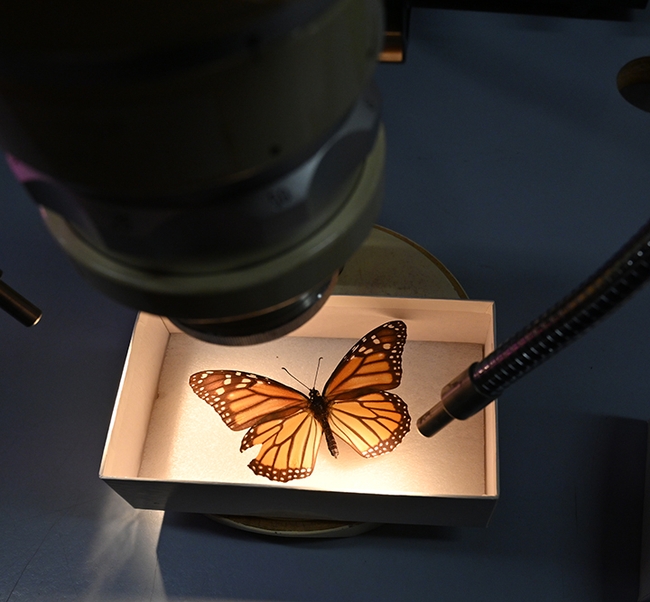
Dingle says:
- "There is not enough tropical milkweed planted to have much influence (see the amount of A. syriaca and A. fascicularis throughout the American West not to mention various other species like A. erosa, cordifolia, californica, etc.) Yes, there are parasites on A. curassavica as there are on ALL milkweeds."
- "There are populations of monarchs that are doing just fine feeding exclusively on A. curassavica (e.g. on many Pacific Islands, such as Guam where I have studied them."
- "Migration and the diapause that accompanies it in the fall are determined by shortening photoperiod and temperature (warm temps can override short days hence the issue with climate change). There is no significant influence of food plant."
Elizabeth Crone. Crone focuses her research on population ecology, "especially of plants and insects, and plant-animal interactions. Specifically, I am interested in how environmental changes translate to changes in population dynamics in animals. I was also one of the first ecologists to use generalized linear mixed models to parameterize stochastic population models." She co-authored "Why Are Monarch Butterflies Declining in the West? Understanding the Importance of Multiple Correlated Drivers," published in 2019 in Ecological Applications, Ecological Society of America.
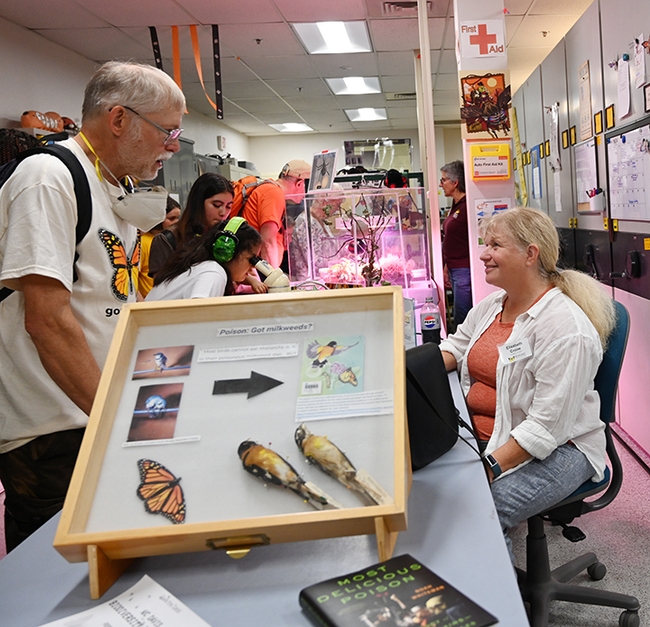
Art Shapiro. Professor Shapiro shared several handouts, including "Comments on Monarchs." He co-authored research (lead author Anne Espeset and six other colleagues) titled, "Understanding a Migratory Species in a Changing World: Climatic Effects and Demographic Declines in the Western Monarch Revealed by Four Decades of Intensive Monitoring," published in Population Ecology.
"None of my group is a Monarch specialist, and that includes me," Shapiro wrote in the handout. "Since 1999 I have done counts of all butterfly species at 4 Valley sites (Suisun, West Sacramento, North Sacramento and Rancho Cordova) using standard 'Pollard walk' methods, slightly modified. As a result we have a quantitative picture of Monarchs in breeding season over 14 years. Such data are very rare. Population estimates of Monarchs are typically based on the overwintering (non-breeding) aggregations and we know from published material that what breeding-season data exist routinely diverge from the overwintering data. That is, trends in population size as measured by overwinter animals are not routinely reflected in the summer numbers. There can be a variety of explanations for this. To me the most likely is that as a very mobile species, the Monarch may breed in different places in different years, so that a monitoring program like mine, based on a limited number of fixed, Intensively-monitored sites, is unlikely to capture this stochasticity in where Monarchs breed."
Over the last 50 years, "Suisun has had the highest counts (of monarchs), partly but not entirely reflecting coastward migration from farther inland early in the season, but these high numbers have effectively disappeared—perhaps reflecting a systematic change in migratory trajectories."
Also at the open house, entomologist Jeff Smith, who curates the Bohart's Lepidoptera collection, and colleague Greg Kareofelas showed visitors drawers of monarch and other butterfly specimens.
Two origami monarchs, the work of UC Davis alumnus Kevin Murakoshi of Davis and a gift to the Bohart Museum, drew special attention. Murakoshi earlier crafted origami praying mantises, ticks and bed bugs for Bohart Museum open houses.
One of the books displayed at the open house was UC Berkeley professor Noah Whiteman's newly published work, "Most Delicious Poison: The Story of Nature's Toxins--from Spices to Vices" (Little Brown Spark, Oct. 24, 2023) It includes information on the toxicity of milkweed.
The Bohart Museum, directed by UC Davis distinguished professor Lynn Kimsey, is located in Room 1124 of the Academic Surge Building, 455 Crocker Lane, UC Davis campus. It is the home of a global collection of eight million insect specimens. It also houses a live "petting zoo" (including Madagascar hissing cockroaches, stick insects and tarantulas) and a gift shop.
Attached Images:
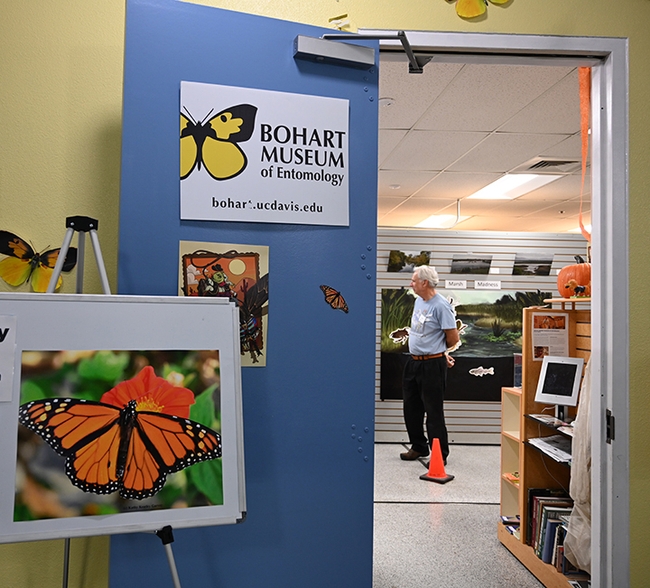
An enlarged image of a monarch butterfly (by Kathy Keatley Garvey) graced the entrance to the Bohart Museum's open house on monarchs. In back is Bohart associate Mike Pitcairn, retired entomologist from the California Department of Food and Agriculture. (Photo by Kathy Keatley Garvey)
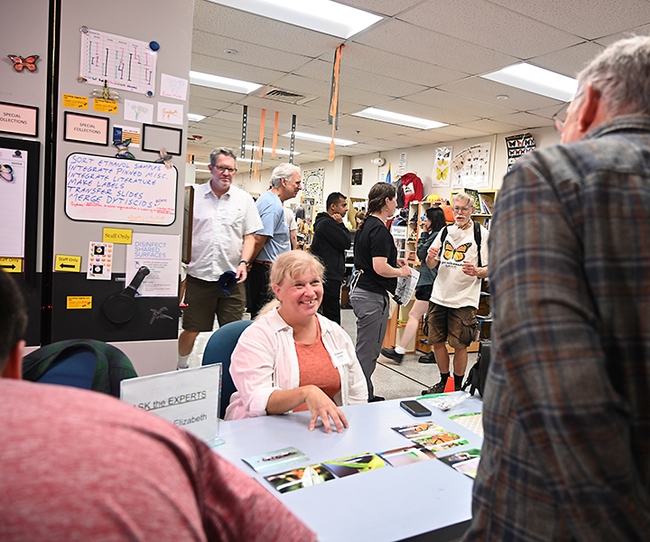
UC Davis professor Elizabeth Crone of the Department of Evolution and Ecology, formerly of Tufts University, answers questions about monarchs. (Photo by Kathy Keatley Garvey)
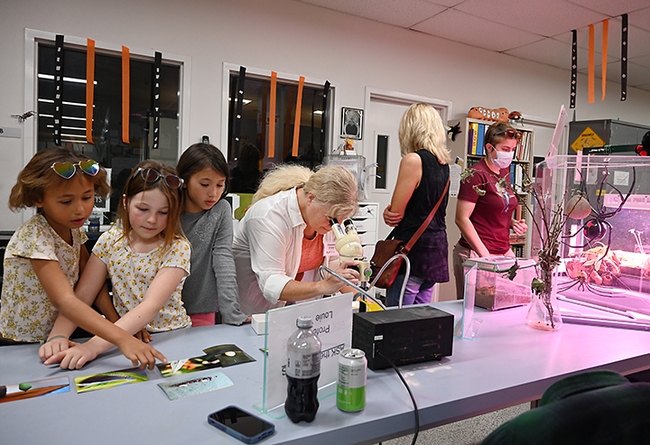
Professor Elizabeth Crone encouraged visitors to look at the butterfly scales through a microscope. Next to her: girls examining the display. (Photo by Kathy Keatley Garvey)
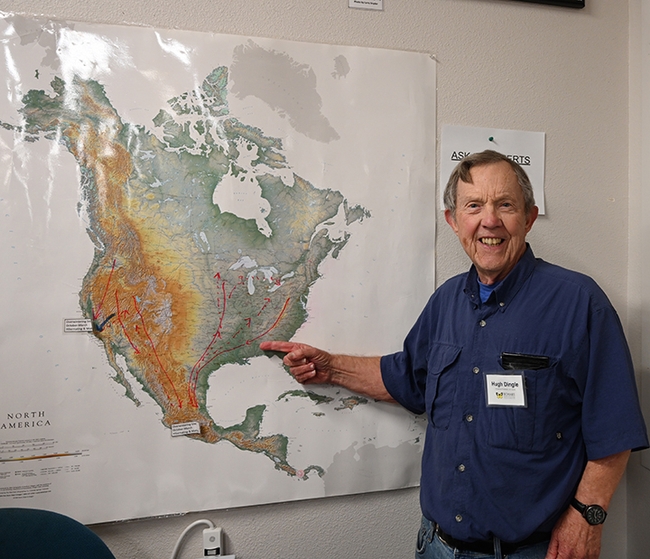
UC Davis emeritus professor Hugh Dingle, a worldwide authority on animal migration, including monarchs, displays a monarch migratory map. (Photo by Kathy Keatley Garvey)
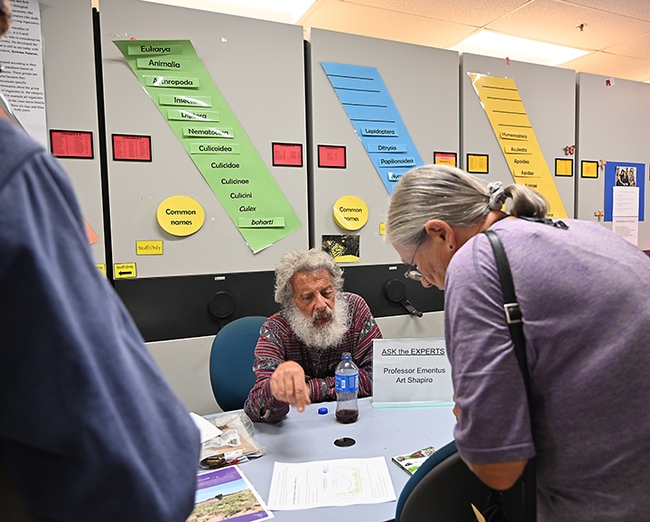
UC Davis emeritus professor Art Shapiro, who has monitored butterfly populations in central California for 50 years, explains his work. (Photo by Kathy Keatley Garvey)
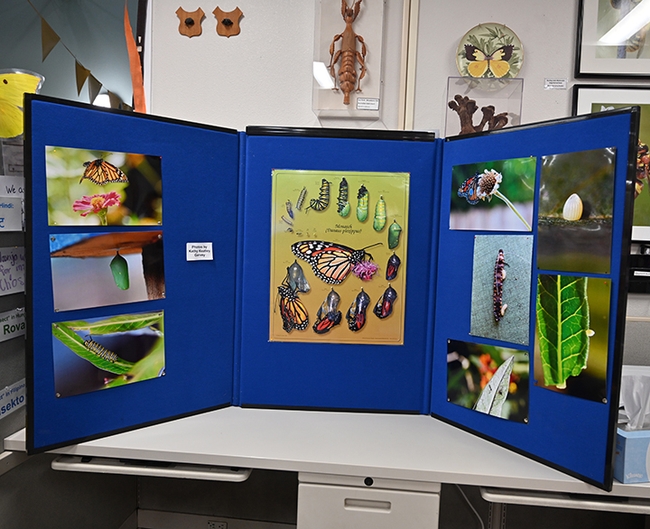
A Bohart Museum display showing photos of life stages of monarchs, and a tachinid fly infestation. (Photo by Kathy Keatley Garvey)
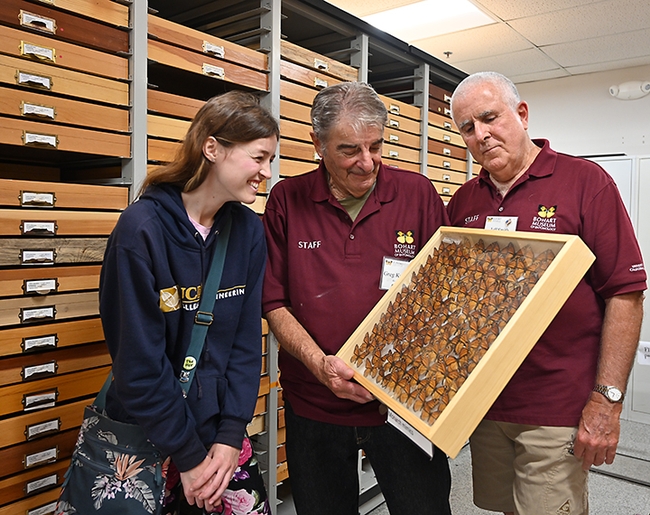
Catherine Tate, a fourth-year UC Davis student majoring in chemical engineering, asks questions of Bohart associates Greg Kareofelas (center) and Jeff Smith, curator of the Lepidoptera collection at the Bohart. (Photo by Kathy Keatley Garvey)
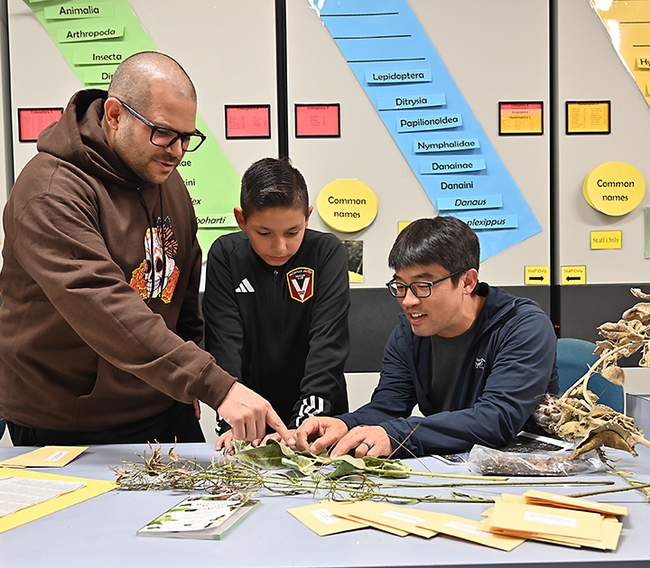
UC Davis professor Louie Yang (right) shows milkweed to Mike Silva, professor at Solano Community College and a City of Vacaville councilman, and his son, Jovanni Silva. Silva is planning a milkweed project in Vacaville. (Photo by Kathy Keatley Garvey)
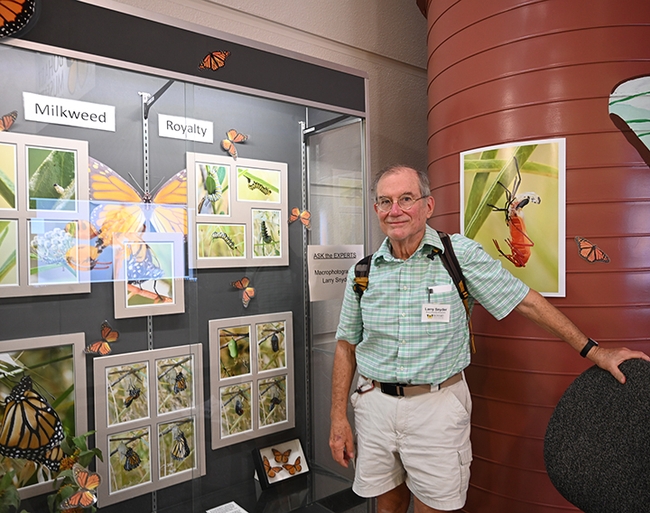
Macro photographer Larry Snyder of Davis answered questions about his monarch display in the hallway of the Academic Surge building. He took images of a monarch-milkweed project organized and led by UC Davis Professor Louie Yang. (Photo by Kathy Keatley Garvey)
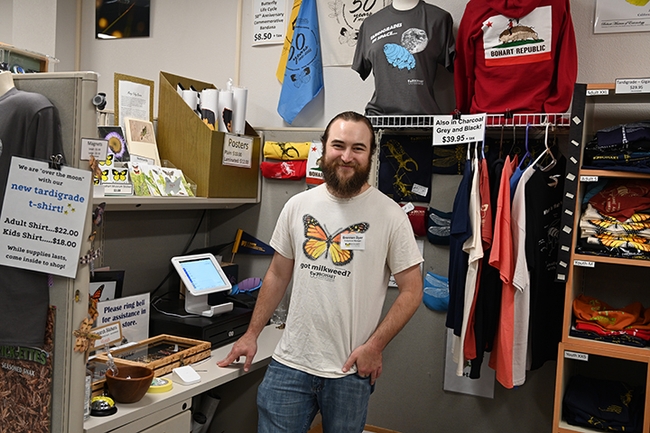
Brennen Dyer, the Bohart Museum's collection manager, wearing a monarch t-shirt from the gift shop. (Photo by Kathy Keatley Garvey)
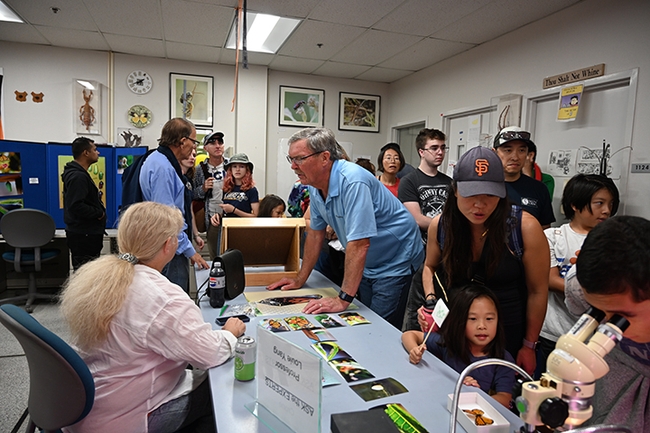
Some 650 visitors attended the Bohart Museum of Entomology open house on monarchs. In the foreground is monarch researcher UC Davis Professor Elizabeth Crone. (Photo by Kathy Keatley Garvey)